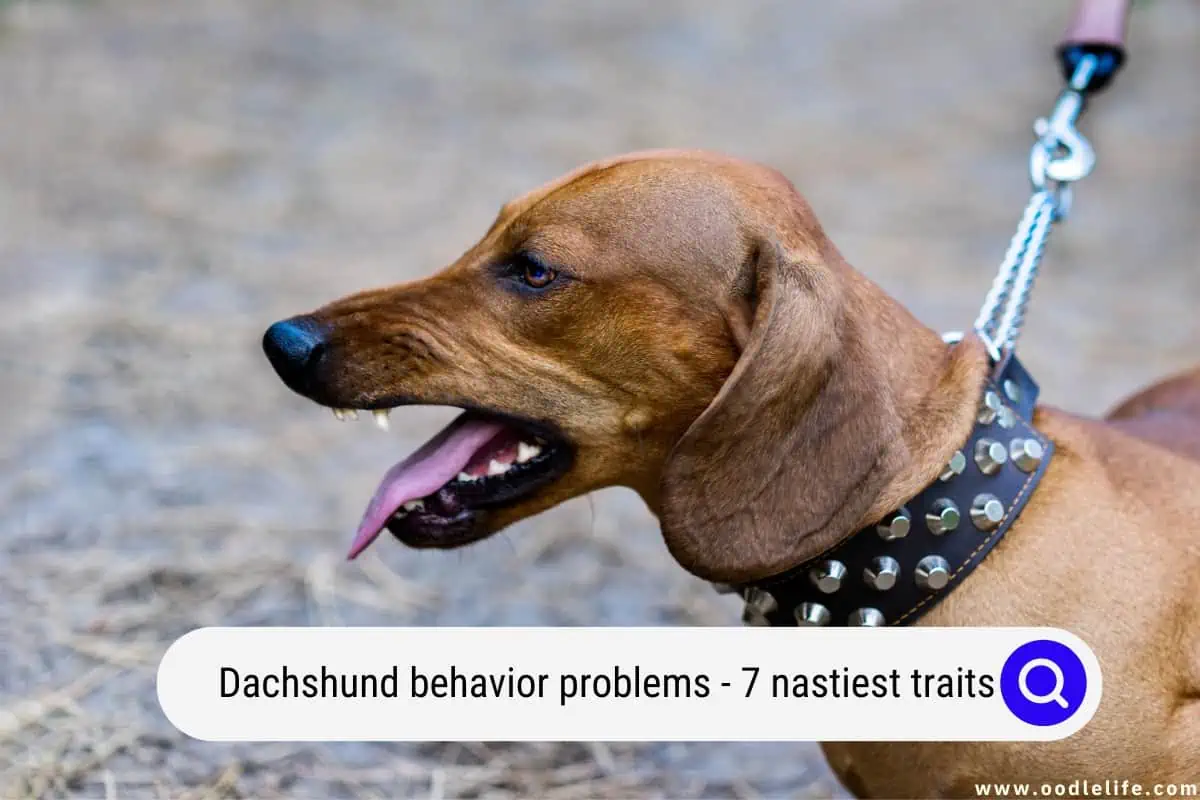Dachshund Behavior Problems (7 Nastiest Traits)
Dachshunds have diminutive stature and make great companions. However, they can develop behavioral issues like any other dog breed if they don’t receive adequate training and care. But that does not mean the owner is to blame every time a Dachshund exhibits behavioral issues.
Rearing a dog is an endeavor fraught with difficulties. Furthermore, attempting to provide the Dachshund with what it wants and being overly conscientious leads to undesirable outcomes. Read on to learn about the five most annoying Dachshund behavior and how to solve them.

| Behavior Problem | How Common | How It Shows |
| Excessive Barking | ⭐⭐⭐⭐⭐ | A Dachshund barks loudly and incessantly when someone passes by the window or rings the doorbell. |
| Digging | ⭐⭐⭐⭐ | A Dachshund digs holes in the garden or tries to dig into the carpet, causing damage to the property. |
| Separation Anxiety | ⭐⭐⭐⭐ | A Dachshund becomes anxious, whines, or destroys furniture when left alone at home. |
| Resource Guarding | ⭐⭐⭐⭐ | A Dachshund growls or snaps when someone approaches their food, toys, or favorite resting spot. |
| Jumping Up | ⭐⭐⭐ | A Dachshund jumps on guests or family members, potentially causing scratches or discomfort. |
| Leash Pulling | ⭐⭐⭐ | A Dachshund pulls on the leash while on walks, making it difficult to maintain control and causing strain on their back. |
| Nipping/Biting | ⭐⭐⭐ | A Dachshund nips at people’s heels or hands, especially during play or when they feel threatened. |
| House Soiling | ⭐⭐ | A Dachshund eliminates indoors, despite being house-trained, usually due to anxiety or a lack of a proper schedule. |
| Aggression Towards Dogs | ⭐⭐ | A Dachshund snarls, growls, or snaps at other dogs, making it difficult to socialize or go on walks. |
| Fear/Phobia | ⭐⭐ | A Dachshund becomes terrified of loud noises, like thunderstorms or fireworks, and may hide or panic during these events. |
1. Excessive Barking
Constant barking can be annoying and exhausting. To help your Dachshund stop this undesirable behavior, you’ll need to identify the underlying cause.

The most common reasons for excessive barking in Dachshunds are:
- Lack of mental stimulation
- Poor socialization
Dachshunds are highly energetic dogs and need regular activity to keep them occupied. If you don’t provide enough mental stimulation or training for your Dachshund, they will become bored and anxious, which can lead to excessive barking.
What To Do?
Ensure to give your Dachshund plenty of playtime and activities to prevent boredom. That may include taking them out for walks and teaching them tricks. You can also try providing them with puzzle toys and chews to help keep their minds engaged.
It’s essential to be consistent with your rules when it comes to barking. Tell them to stop barking whenever your dog barks and redirect them to another activity.
Pick a spot that has a direct view from the door. Teach them to lie on the floor and stay in one place when you command them to do so. That keeps them from making too much noise and gives them something to do while waiting to be greeted.
You can call a friend over with a treat, but don’t let them in until your dog is calm. A consistent application of this technique will teach them to calm down in anticipation of a reward.
Consider hiring a professional dog trainer if you’re having trouble correcting your Dachshund’s barking. They can help you identify the underlying cause of your dog’s barking and devise a plan to help curb the behavior.
2. Housebreaking
Housebreaking entails teaching your dog to defecate outdoors. Unfortunately, Dachshunds are notoriously difficult to housetrain. The process might take anything from one to three months.

Even after completing their housebreaking training, Dachshunds can still mess around.
What To Do?
You need to set up a potty-training routine first. Designate a spot in your home and ensure your Dachshund knows that it is their bathroom area. If your Dachshund is new, you should start the training process when they enter your home.
Give them a potty break at least once before bedtime.
You should also monitor for signs that your Dachshund needs to relieve themselves. Take them out immediately if you catch them sniffing or circling the area. It’s best to use positive reinforcement, so ensure to praise and give your dogs treats when they go to the right place.
Furthermore, you shouldn’t adjust your Dachshund’s routine during housebreaking training. Feed them at the same time and in a similar manner.
If your Dachshund has an accident, don’t scold them. Instead, clean up the mess and start fresh. That way, you can successfully housebreak your dog and minimize behavior problems in the future.
3. Separation Anxiety
Dachshunds are prone to developing separation anxiety if you leave them unsupervised for longer periods. The behavioral problem can manifest in various ways, including gnawing, seclusion, barking, nipping, and biting.

What To Do?
Create a safe and comfortable environment for your dogs while you’re gone. That could mean providing them with toys to keep them busy. If you’re going to be away for days, plan and look into getting a dog sitter.
In addition, consider increasing the time that you leave them alone. Start with short intervals and gradually increase the amount of time your pet is alone. That will allow them to become more accustomed to being without you and build the confidence necessary to handle longer absences.
Make them understand that you need some time at home and that they shouldn’t be accompanying you everywhere. You should also give them adequate attention and exercise when together. Playing games and cuddling are excellent ways to relax your pet when leaving them alone.
4. Begging for Food
Dachshund’s enticing expressions, which promote begging, may be hard for you to ignore. Unfortunately, most dog owners reward their pets’ begging behavior by feeding them at the table. The behavior’s possible side effects include being overweight, gastrointestinal issues, and chronic diarrhea.

What To Do?
You should avoid making eye contact with your dog or giving in to their pleading eyes. It may be difficult to ignore your dog when begging for food, but staying consistent is essential. That will help your Dachshund understand that begging won’t get them what they want.
It would be best if you also fed your dog on a schedule. If they’re used to being fed whenever they beg, they may not realize there’s a regular feeding time. Ensure they know when mealtime is by offering food throughout the day.
Alternatively, you can give your dog something else to do when you’re having your meals instead of staying at the table begging. Consider putting your dog’s bowl near the table during mealtime to help them think they’re dining with you. You may also keep your Dachshund in their crate or room while eating so they won’t disturb you.
5. Chewing
Chewing is a normal behavior for dogs, including Dachshunds. However, excessive chewing isn’t desirable, as it can cause damage to your belongings and potentially harm your dog. It can cause dental problems for the dog, including tooth decay or tooth loss.

Moreover, if your dog is chewing on something they’re not supposed to, they could ingest it. That may induce choking and other digestive problems.
What To Do?
Ensure that your Dachshund is getting enough physical and mental exercise. Bored dogs are more likely to engage in destructive chewing, so providing your dog with plenty of opportunities to run, play, and explore can help prevent this problem.
If you find them chewing the furniture, electrical wires, shoes, or anything else, interrupt the behavior by making a loud noise, such as clapping your hands and redirecting them to a chew toy. That teaches them that chewing on certain things is not acceptable.
Furthermore, use a deterrent spray on your expensive furniture. Refrain from confusing your dog by giving them unwanted household items, such as worn-out shoes and torn pillows. That will ensure they learn the distinction between appropriate and inappropriate chewing.
Final Thoughts
Dachshunds are small, energetic dogs that everyone would want to own. However, like all breeds, they can sometimes exhibit unwanted behaviors. The most prevalent Dachshund behavior problems include barking excessively, chewing, begging for food, and separation anxiety.
The key to dealing with behavior problems in Dachshunds is to be patient and consistent. By providing your Dachshund with the right environment and training, you can help them overcome these issues and become happy, well-behaved dogs. It is always best to consult a veterinarian or professional dog trainer if you are concerned about your Dachshund behavior.